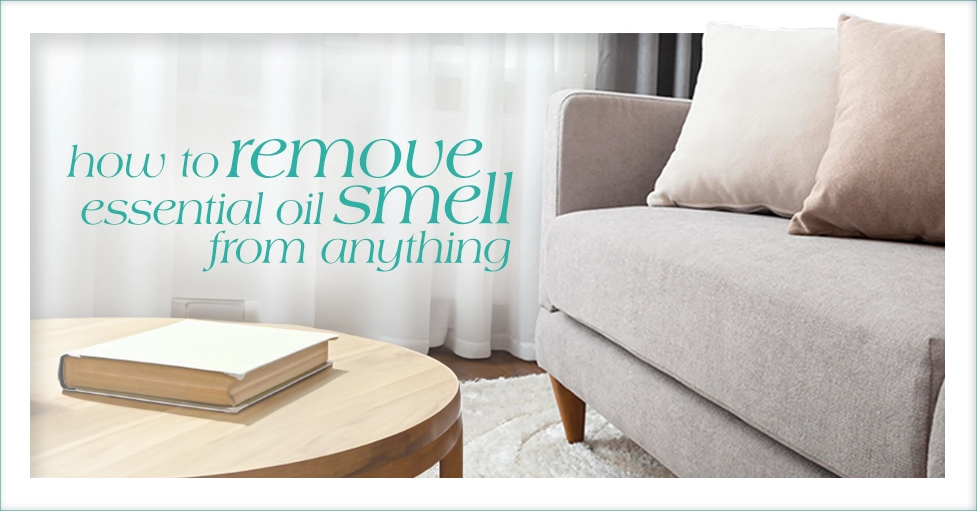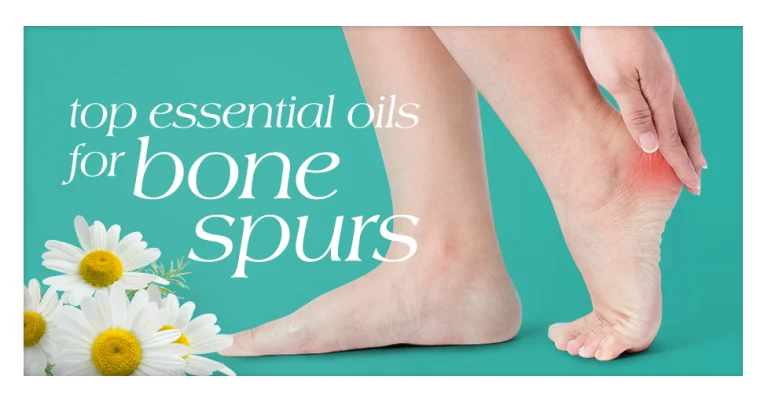How To Remove Essential Oil Smell From Anything
Essential oils are beloved for their natural aromas and therapeutic benefits, ranging from soothing lavender to invigorating peppermint. However, accidents happen — a spill can leave your space with an overpowering scent, or repeated use might leave lingering odors on your clothes and in containers. Whether it’s the intense fragrance of eucalyptus essential oil permeating your living room or the lingering presence of tea tree in your wardrobe, this guide offers solutions to refresh your environment and belongings and remove the strong smell asap.
How To Remove Essential Oil Smell From…
Health Impacts of Lingering Odors
Overwhelming odors essential oil spills can have adverse effects on health, potentially causing discomfort and impacting overall well-being. Breathing in strong peppermint fumes, for example, may lead to stinging eyes, runny nose, hot flashes, dizziness, headaches, sores in the mouth and could even trigger burning mouth syndrome. The intensity of the lingering smell, can also affect breathing, leading to respiratory issues and overall discomfort.

Lingering odors have the potential to disrupt sleep patterns, further exacerbating the negative health impacts. In severe cases, persistent odors may prompt individuals to consider drastic measures like relocating to avoid the health consequences. Therefore, it’s crucial to address spills promptly and effectively to prevent these health issues from arising.
In addition, kids, pets and the elderly are most susceptible to the concentrated fumes of essential oils. In the immediate aftermath of an essential oil spill, you need to proactively manage access to the area. Remove vulnerable parties from the premises immediately and, if necessary, seek professional medical advice or call your vet in the case of dogs or cats.

[ays_survey id=”2″]
How To Remove Essential Oil Smell from Room
The first step in tackling strong essential oil smells in a room is to ventilate the space. Open windows and use fans to circulate fresh air, effectively diluting the overpowering scent. For persistent odors, consider using a combination of natural and commercially available odor neutralizers. Baking soda, coffee grounds and activated charcoal are excellent at absorbing smells; place bowls filled with either around the room for a couple of days.
Start Scent Absorption Immediately
As soon as you spill essential oils you must mitigate immediately by purifying and filtering the air with and ionizer, an HVAC machine, or an air purifier. In addition, an ozone generator is also a great item to have on hand in case of an essential oil spill. Regardless, if you don’t have access to these, quickly open the windows, turn on any fans you have or an air-conditioner to help reduce the scent.

Baking Soda: A Natural Odor Eliminator
Baking soda, renowned for its exceptional odor-absorbing properties, stands as a natural and effective solution for banishing unwanted smells in various settings. Its versatility extends to removing odors from gas spills in vehicles, eliminating wet carpet odors after a storm, and tackling musty carpet smells by sprinkling it liberally.
Placing bowls of baking soda directly in rooms can help neutralize various household odors, making it a go-to option for many seeking a chemical-free deodorizing solution. With its ability to absorb and neutralize odors, baking soda proves to be a reliable and eco-friendly choice for those looking to freshen up their living spaces without harsh chemicals or fragrances.
White Vinegar for Stubborn Odors
White vinegar serves as a potent and versatile solution for combating persistent odors in various living spaces. Its acidic properties make it effective in neutralizing and eliminating stubborn smells, including cigarette smoke, pet odors, and musty mildew scents.
To use white vinegar for odor removal, simply mix equal parts vinegar and water in a spray bottle and apply it to the affected areas. The vinegar will help break down the odor-causing compounds, leaving the space smelling fresh and clean.
Additionally, white vinegar is a natural and eco-friendly alternative to harsh chemical cleaners, making it a safe option for households looking to eliminate odors without introducing harmful substances into their living environment.

Ozone Generators Can Remove Odors Fast
Charcoal for Air Purification
Charcoal, known for its exceptional absorbing properties, is a highly effective natural solution for air purification in indoor environments. Activated charcoal works by trapping toxins and chemicals in its tiny pores, preventing them from recirculating in the air.
Activated charcoal can effectively remove odors, allergens, and pollutants, enhancing indoor air quality. Unlike synthetic air fresheners that mask odors, charcoal absorbs and eliminates them at the source. While passive and relatively slow, this natural method is particularly beneficial for individuals sensitive to artificial fragrances or harsh chemicals.
Rubbing Alcohol for Oil Spill Cleanup
When dealing with essential oil spills, a practical approach involves saturating a cotton ball with rubbing alcohol for efficient cleanup. Rub the affected area with the cotton ball to get rid of the oils, allowing the alcohol to evaporate quickly and aid in odor removal.
This method is particularly effective for small spills on surfaces like countertops or floors. Ensure the area is well-ventilated (wearing a mask and even eyeglasses is recommended) during the cleanup process to prevent inhalation of fumes.
Using Oxidizers, Deionizers and Other Chemicals for Scent Removal
Additionally, deionization technology, oxydizers and chemical odor neutralizers offer an innovative approach and solid options to quickly, effectively control and eliminate odors in various environments. These work by removing charged scent particles from the air, by reacting with scent molecules in the air (oxydizers) causing them to weigh down and settle, or by using chlorine dioxide gas to modify the composition of odor-causing molecules.
Unlike traditional air fresheners that merely mask odors, these can help tackle the root cause of unpleasant scents, restoring a fresh and clean environment. The ability to provide long-lasting odor control makes it a valuable tool for addressing persistent odor issues in homes, offices, and commercial spaces.
Note, enzyme cleaners can also be useful at fighting odors, but these are NOT going to be very useful or particularly effective for essential oils.
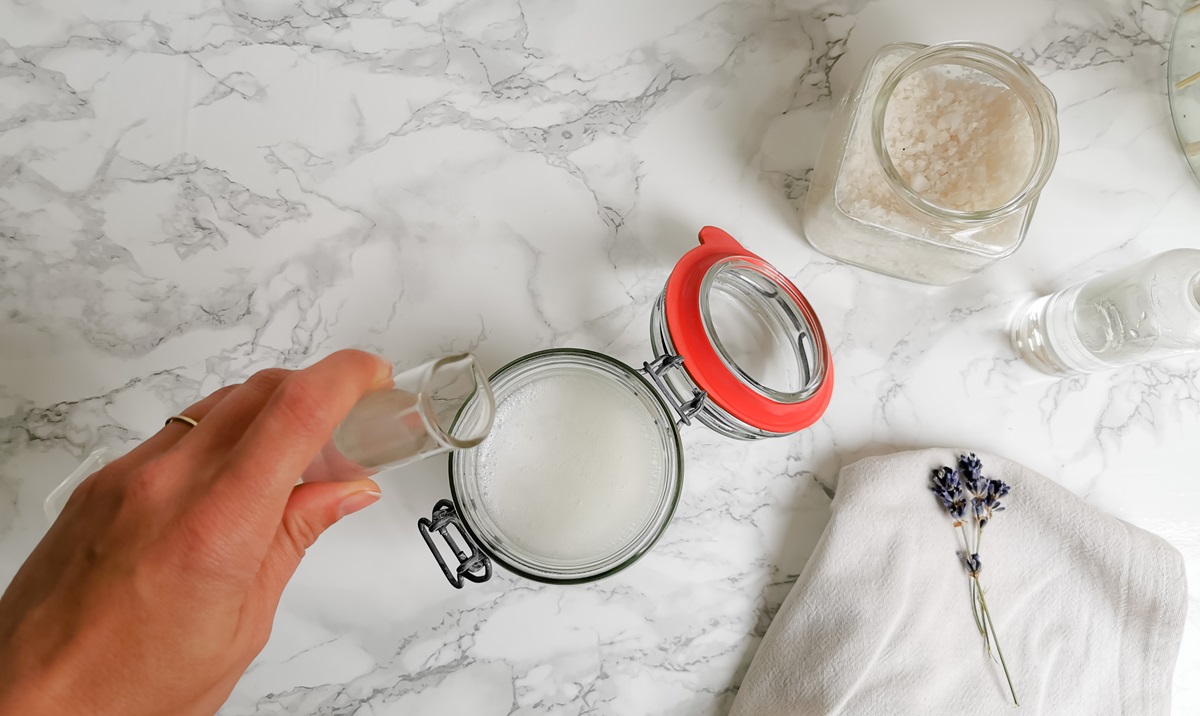
Expert Tricks Unveiled For Clothing and Furniture
Embarking on the mission to conquer essential oil stains proves to be a meticulous endeavor that demands prompt action, precision and expertise. As these potent oils seep into fabrics, leaving lasting imprints, the challenge lies in unraveling the secrets of how to remove essential oil smell from fabric and banishing these stubborn marks effectively.
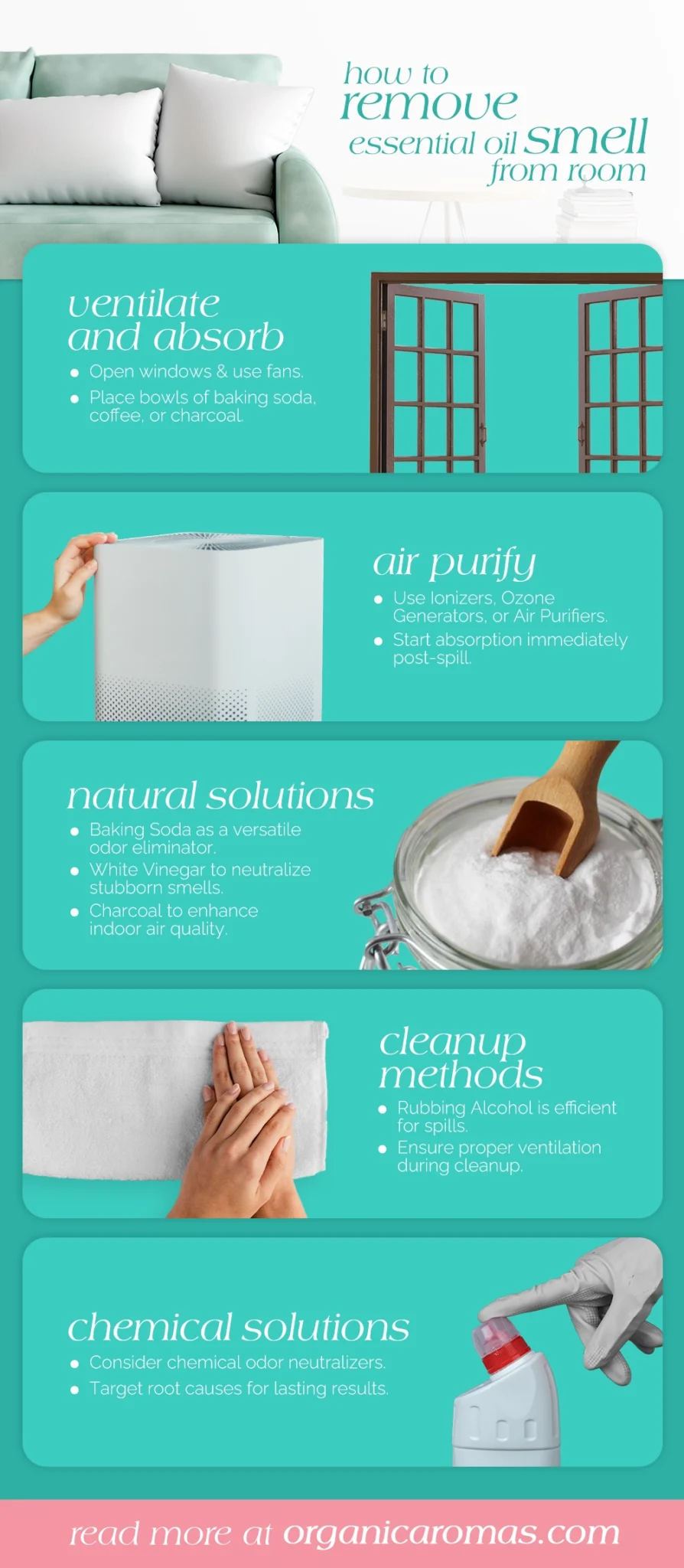
How to Remove Essential Oil Smell from Fabric
Understanding Essential Oil Characteristics
Understanding the distinctive characteristics of essential oils is fundamental for effectively addressing stains caused by their unique composition and properties. Essential oils are pure extracts derived from plants through steam distillation, containing compounds like terpenoids and sesquiterpenes. They are volatile compounds that will evaporate and weaken with time, so please don’t worry.
The only risk comes with breathing too much or perhaps in some cases the oils could have a corrosive affect on whatever they touch. Otherwise, some “dark essential oils” could stain clothes. These are essential oils that are extracted from “gums” and resins of trees or have a dark color, which often correlates being from a root system, seeds, or tree bark, but it does vary.
Unlike thick carrier oil such as castor or coconut oil, essential oils have a lighter consistency, facilitating deep penetration into fabrics. The darkness of essential oils often corresponds to the intensity of stains on clothes, with diluted or undiluted oils capable of causing dark patches or discoloration.
Due to their ability to deeply permeate fabric fibers, essential oils present challenges in stain removal, requiring specific techniques to ensure successful elimination without causing further damage.
How to Remove Essential Oil Smell From Clothes/Fabric
Deeply ingrained in fabric fibers, essential oils can stain clothes and can pose a formidable challenge due to their strong adherence and the difficulty in removal with conventional cleaning methods. These oils have the ability to deeply penetrate fabrics, making it hard to eliminate them in the washing machine alone.
Water alone often proves ineffective in eradicating these stubborn stains as pure essential oils are not miscible in H2O. Additionally, diluted and undiluted essential oils can lead to dark patches or discoloration on clothes, further complicating the stain removal process. The unique characteristics of essential oils, such as their thin consistency and potent organic compounds, contribute to the challenges faced when trying to to remove stains from fabrics.
Therefore, specialized stain removal techniques are typically required to tackle these persistent oil stains effectively.
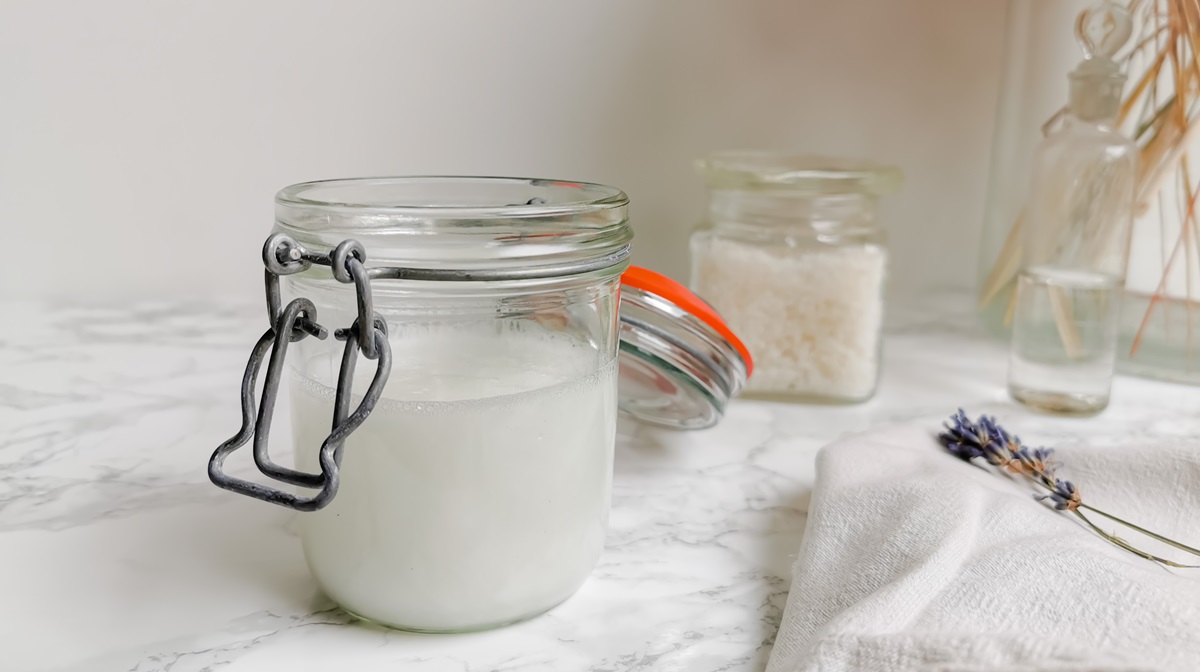
Effective Stain Removal Methods
When dealing with essential oil stains, employing effective stain removal methods is crucial to successfully eliminating the stubborn marks from clothing, whether it be natural or synthetic fabrics. Absorbents like talcum powder, salt, or flour can help lift and dissolve oil stains from fabric, while dish-washing liquid or laundry detergent with a small brush can aid in targeting oil spots.
White or distilled vinegar can be used to soak fabric for more resistant stains, and pre-soaking fabric in 70% rubbing alcohol or isopropyl alcohol can assist in removing darker stains. Dabbing fresh stains with water can prevent them from setting in fabric, and for deep stains, laundry soap solutions or alcohol can be effective as a pre-treatment prior to washing machines.
Additionally, creating a stain removal solution by mixing water, dishwashing detergent, and even glycerin can be beneficial in tackling essential oil stains.
Absorbents for Oil Stain Removal
In addressing the challenge of essential oil stains on fabrics, the use of absorbents such as talcum powder, salt, or flour plays a crucial role in effectively lifting and removing the oils from the fabric fibers. These absorbents work by drawing out the oils from the fabric, helping to break down the stain and make it easier to further remove oil stains.
Talcum powder, salt, and flour are particularly effective in absorbing excess oil from the fabric surface, preparing it for further stain removal treatments. By applying these absorbents to the oil-stained area and allowing them to sit for a period of time, the oils are gradually lifted from the fabric, improving the overall stain removal process.
Using Dishwashing Liquid and Detergent
Utilizing a few drops dishwashing liquid and detergent is a practical approach in effectively tackling essential oil stains on fabrics just like it is for grease stains. When dealing with these stains, it is crucial to act promptly.
Begin by applying a generous amount of dishwashing liquid or detergent directly onto the stained area. Gently rub the fabric together to work the cleaning agents into the fibers. Allow it to sit for a few minutes to penetrate the stain.
Then, rinse the fabric thoroughly with cold water (warm water is fine). For tougher stains, consider using a soft brush to work the detergent into the fabric before rinsing with hot water. This method can help break down the oils and lift them from the fabric, improving the chances of successful stain removal.
Naturally, this action could be damaging to the fabric itself so go slow and be patient! Also, wear a mask and take frequent breaks.
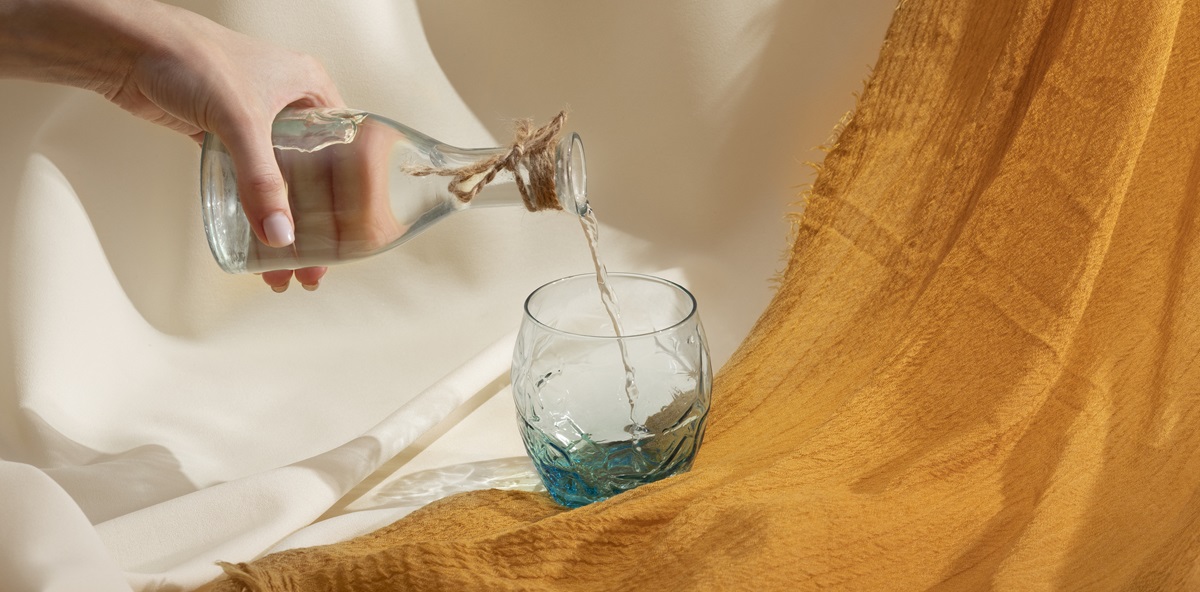
Vinegar Soaking for Stubborn Stains
For effective removal of stubborn stains caused by essential oils, consider soaking the fabric in white or distilled vinegar. Vinegar’s acidic properties help break down the oils, making them easier to lift from the fabric fibers.
To use this method, mix equal parts vinegar and water in a bowl or container large enough to submerge the stained area. Allow the fabric to soak for at least 30 minutes, or overnight for more stubborn stains. After soaking, put the garment in the washing machine as usual with laundry detergent for a complete wash cycle.

Sign Up to Get Your FREE
e-Book Here…
Vinegar soaking is particularly effective for light to moderate essential oil stains and can be a gentle yet powerful solution for restoring your clothing to its pristine condition.
Alcohol-Based Solutions for Dark Stains
When faced with stubborn and deeply ingrained essential oil stains, turning to alcohol-based solutions can offer a potent method for effectively lifting dark discolorations from fabric fibers.
Alcohol, such as rubbing alcohol or isopropyl alcohol, acts as a solvent that helps break down the oils in the stain, making it easier to lift from the fabric. To use this method, dampen a clean cloth or paper towel with a few drops of alcohol and gently dab at the stained area. Avoid rubbing excessively, as this can spread the stain further. It also could damage the fabric. Go slow.
Repeat the process until the stain diminishes. Once the stain is lifted, running the fabric through a washing cycle as usual to remove any residue.
Last Resort: Baking Soda for Stain Removal
As a final measure in the arsenal of stain removal techniques, baking soda emerges as a reliable and effective solution for combating tough stains before laundering.
Baking soda, with its mild abrasive properties and alkaline nature, can help break down and lift stubborn stains, including those caused by essential oils.
To use baking soda for stain removal, create a paste by mixing it with water and gently scrub it onto the affected area using a soft brush, cloth, or old toothbrush. Allow the paste to sit for a few minutes to penetrate the fabric before rinsing it off. Repeat this process as needed until the stain diminishes.
Even trying a baking soda white vinegar mixture serves as a versatile and affordable option for treating persistent stains effectively. After washing, you can add a few drops of lemon essential oil (for its’ antibacterial properties) to a dryer sheet to make clothes fresh.
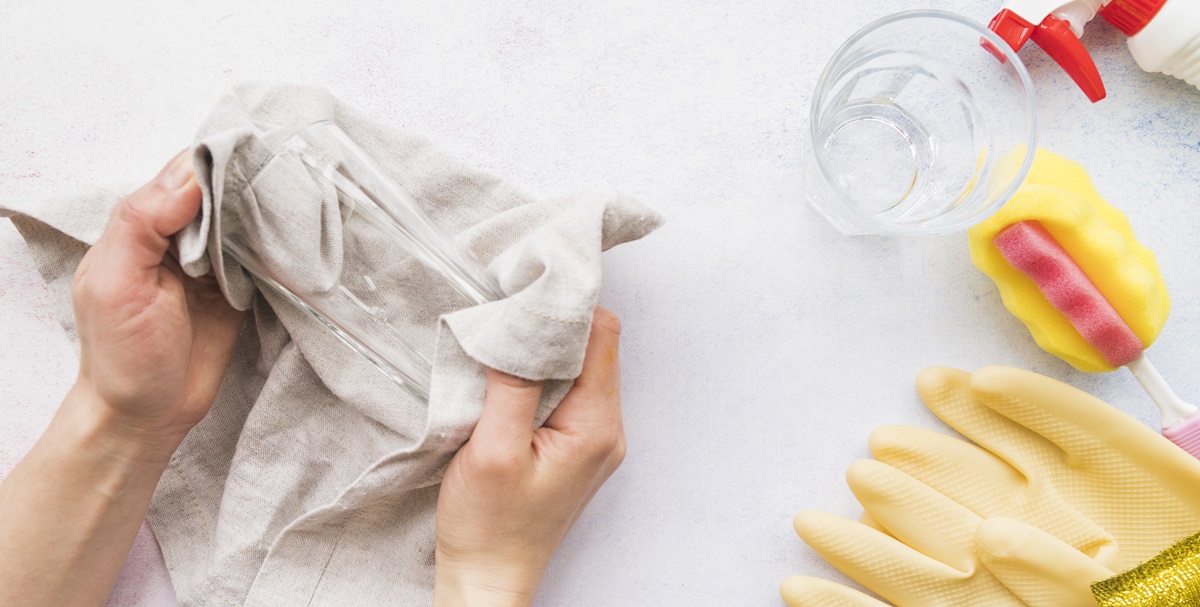
How To Remove Essential Oil Smell From Plastic or Glass Containers
Are you struggling to rid your kitchenware of that stubborn odor that just won’t quit, no matter how many times you’ve tried to eliminate it? Let’s uncover the secrets to effectively banishing those persistent smells from your silicone and plastic kitchen items.
Understanding Odor Retention in Silicone
When dealing with silicone kitchenware, understanding why it retains odors is crucial for effective odor removal.
Silicone’s unique molecular structure allows it to absorb smells easily, especially when exposed to heat. Heating silicone causes its molecules to expand, trapping odors within its rubber-like consistency.
While silicone is chemically stable and inert, it can still retain odors if not cleaned properly.
To eliminate smells from silicone kitchenware, washing with dish soap and heating at 250°F (120°C) can help break down and remove the trapped odors.
It’s essential to repeat this process if needed to ensure thorough odor removal and maintain the freshness of your silicone kitchen tools.
Care and Maintenance of Silicone Kitchenware
To care for silicone kitchenware that is stained or deeply penetrated by the aroma of essential oils, we recommend first hand washing with mild dish soap. Avoid abrasive cleaners that can damage the surface. To remove odors, baking silicone items at 250°F (120°C) for a about half an hour to 30 minutes can help refresh them. Ensure the silicone is FDA-approved before using this method.
Proper storage in a cool, dry place can also prevent odors from developing. By following these simple care tips, your silicone kitchenware will stay fresh and odor-free for longer.
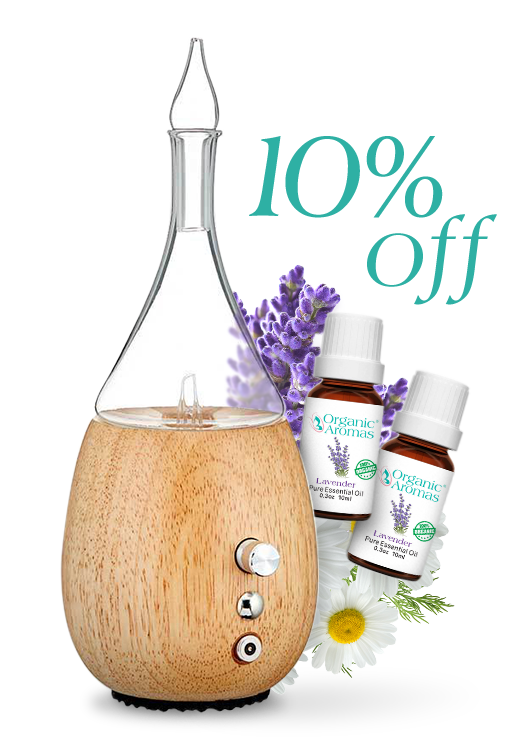
Join Now and Get a Coupon for 10% Off!
Tackling Persistent Plastic Odors
To combat stubborn plastic odors, employing effective cleaning techniques is essential for restoring freshness to your plastic kitchen items. Plastic, derived from hydrocarbons, can retain odors if not cleaned properly. Simple soap and water can be effective, but heat can set odors in plastic. Different grades of plastics require specific care to eliminate smells successfully.
A solution of baking soda, water, and dish soap and prolonged exposure can help neutralize persistent odors in plastic items. It’s crucial to avoid harsh chemicals and opt for gentle yet efficient cleaning methods. By following these steps diligently, you can ensure that your plastic kitchenware remains odor-free and ready for everyday use.
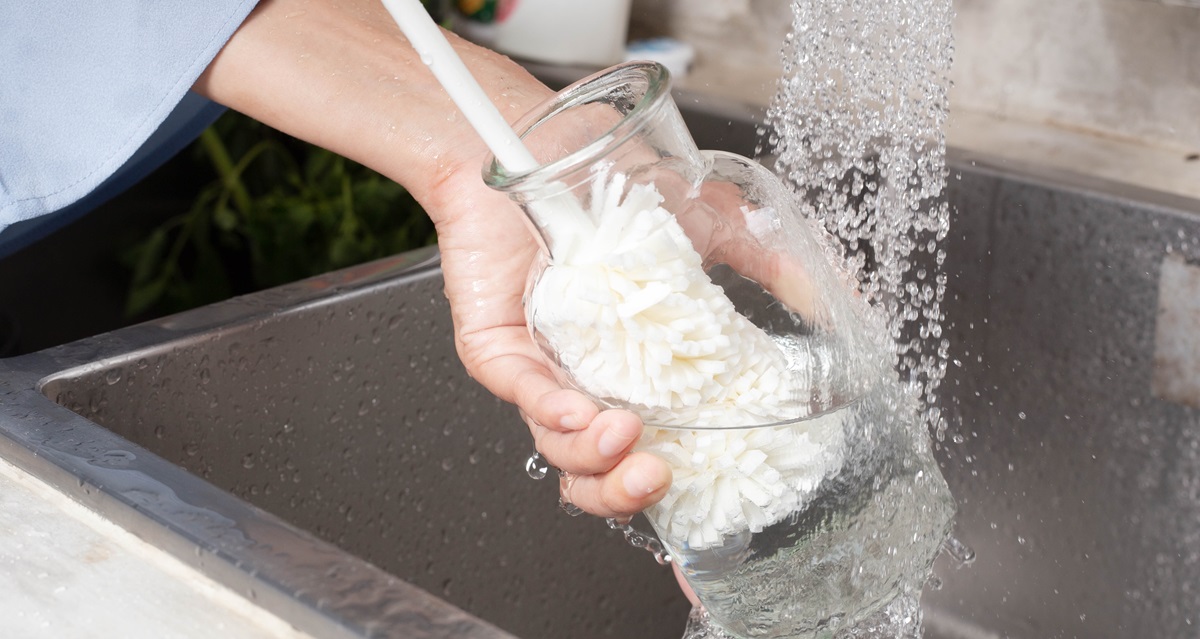
How to Remove Essential Oil Smell from Glass
Removing the smell of essential oils from glass containers involves a few simple but effective steps. Here’s a concise guide:
- Rinse with Warm Water: Begin by rinsing the glass container with warm water to remove any residual oil. Essential oils are oil-soluble, so warm water can help loosen the oil particles from the glass surface.
- Use Dish Soap: Apply a few drops of a mild dish soap to the container. Dish soap is designed to cut through grease and oil, making it effective at breaking down and removing essential oil residues.
- Scrub Gently: With a soft sponge or brush, gently scrub the inside of the glass container. Pay special attention to areas with noticeable oil residue.
- Rinse Thoroughly: Rinse the container thoroughly with warm water to remove all soap residues. Soap residues can also harbor smells, so it’s important to rinse well.
- Baking Soda Paste: For stubborn smells, make a paste with baking soda and water, apply it to the inside of the container, and let it sit for a few hours or overnight. Baking soda is a natural deodorizer and can help neutralize lingering odors.
- Rinse and Dry: Rinse the container again thoroughly with warm water and allow it to air dry completely. Ensuring the container is completely dry before reuse is crucial to prevent any moisture-related issues.
This approach is generally effective for removing essential oil smells from glass containers, leveraging the cleaning power of dish soap and the deodorizing properties of baking soda.
Leveraging Chemical Reactions for Odor Removal
To effectively neutralize stubborn odors in plastic kitchen items, understanding the role of chemical reactions is imperative. Acids, bases, and solvents are key players in this process. Baking soda, for example, can effectively neutralize acidic odors lingering in plastic. Essential oils are generally considered to be neutral to slightly acidic.
Ineffective Methods for Plastic Odor Removal
When trying to eliminate stubborn odors from plastic kitchen items, it’s important to be aware of methods that are ineffective in achieving desired results.
While some may suggest using white vinegar, tomato juice, or lemon juice, these options aren’t effective for removing smells from plastic.
Similarly, despite the common belief that soaking plastic items in a mix of bleach (or even oxygen bleach) and water can help neutralize odors, this method can be harsh on the plastic and may not produce the desired outcome.
It’s crucial to avoid using these ineffective methods and instead opt for more suitable approaches like washing with soap and water, using baking soda, or seeking alternative kitchenware options for better odor control.
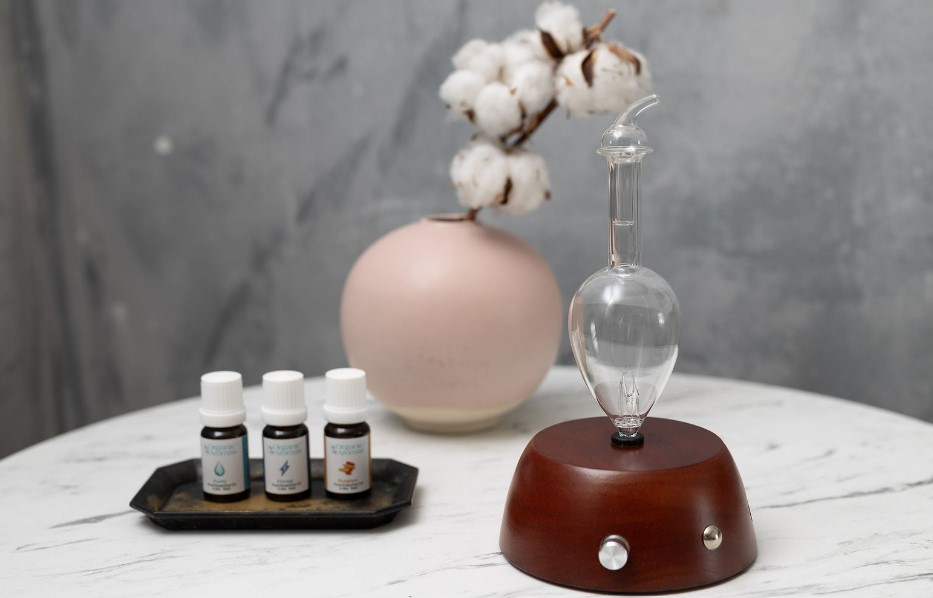
Alternative Kitchenware Options for Odor Control
Considering odor control in the kitchen, exploring alternative kitchenware options becomes essential for maintaining a fresh culinary environment. Glass and stainless steel are excellent choices for fermentation to prevent odor concerns.
These materials are non-porous, reducing odor retention and making them easy to clean. Additionally, using ceramic or porcelain containers can help contain odors effectively. These alternative options not only provide odor control but also add a touch of elegance to your kitchen.
Advanced Techniques for Neutralizing Odors
Exploring innovative methods to effectively eliminate stubborn odors from kitchenware can be a game-changer. One advanced technique involves using a mixture of hydrogen peroxide and baking soda to create a powerful odor-neutralizing paste. Apply this paste to the affected kitchenware, let it sit for a few hours, then rinse thoroughly.
When You Need To Know How To Remove Essential oil Smell
While essential oils offer numerous benefits, managing their potent aromas when spilled or overused can be challenging. By employing the right techniques for the right materials — from airing out rooms to detailed fabric care, and proper container cleaning — you can enjoy the positive aspects of essential oils without the overpowering smells.
Remember, prevention is key: use oils sparingly and always clean spills immediately to maintain a balanced, fragrant environment.
How can I remove the essential oil smell from my furniture?
To remove the essential oil smell from furniture, start by wiping the surface with a mixture of mild dish soap and water. For porous materials like wood, apply a paste of baking soda and water, let it sit for a few hours, then gently wipe away.
If the scent persists, consider using a fabric cleaner for upholstered pieces, and always perform a spot test on a hidden area first to ensure it doesn’t damage the material.
What is the best way to eliminate essential oil odors from my car?
To eliminate essential oil odors from your car, begin by airing out the vehicle with open windows and fans. Clean any spills with a mixture of water and vinegar, and then sprinkle baking soda on carpets and seats to absorb lingering odors.
Vacuum the baking soda after a few hours. If the smell remains, consider using a car upholstery cleaner specifically designed for the material of your seats.
Can I remove essential oil smells from my clothing and how?
Yes, you can remove essential oil smells from clothing. Pre-treat the affected area with a mixture of baking soda and water to absorb the oil, then wash the garment using the hottest water safe for the fabric along with your regular detergent.
Adding a cup of white vinegar to the rinse cycle can also help neutralize the smell. Air-dry the clothing outside if possible, as sunlight can help eliminate odors.
What’s the most effective way to cleanse essential oil aromas from plastic containers?
The most effective way to cleanse essential oil aromas from plastic containers involves soaking them in a solution of baking soda and warm water overnight. Rinse thoroughly the next day and dry completely.
If the smell remains, fill the container with white vinegar, let it sit for a few hours, then wash again with soap and warm water. Sun-drying can also help eliminate any residual odors.

